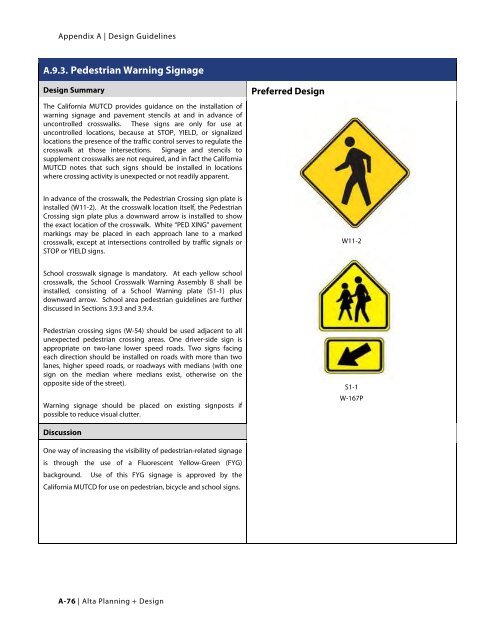City of Oxnard - Bicycle and Pedestrian Master Plan Appendices
City of Oxnard - Bicycle and Pedestrian Master Plan Appendices
City of Oxnard - Bicycle and Pedestrian Master Plan Appendices
You also want an ePaper? Increase the reach of your titles
YUMPU automatically turns print PDFs into web optimized ePapers that Google loves.
Appendix A | Design Guidelines<br />
A.9.3. <strong>Pedestrian</strong> Warning Signage<br />
Design Summary<br />
The California MUTCD provides guidance on the installation <strong>of</strong><br />
warning signage <strong>and</strong> pavement stencils at <strong>and</strong> in advance <strong>of</strong><br />
uncontrolled crosswalks. These signs are only for use at<br />
uncontrolled locations, because at STOP, YIELD, or signalized<br />
locations the presence <strong>of</strong> the traffic control serves to regulate the<br />
crosswalk at those intersections. Signage <strong>and</strong> stencils to<br />
supplement crosswalks are not required, <strong>and</strong> in fact the California<br />
MUTCD notes that such signs should be installed in locations<br />
where crossing activity is unexpected or not readily apparent.<br />
Preferred Design<br />
In advance <strong>of</strong> the crosswalk, the <strong>Pedestrian</strong> Crossing sign plate is<br />
installed (W11-2). At the crosswalk location itself, the <strong>Pedestrian</strong><br />
Crossing sign plate plus a downward arrow is installed to show<br />
the exact location <strong>of</strong> the crosswalk. White “PED XING” pavement<br />
markings may be placed in each approach lane to a marked<br />
crosswalk, except at intersections controlled by traffic signals or<br />
STOP or YIELD signs.<br />
W11-2<br />
School crosswalk signage is m<strong>and</strong>atory. At each yellow school<br />
crosswalk, the School Crosswalk Warning Assembly B shall be<br />
installed, consisting <strong>of</strong> a School Warning plate (S1-1) plus<br />
downward arrow. School area pedestrian guidelines are further<br />
discussed in Sections 3.9.3 <strong>and</strong> 3.9.4.<br />
<strong>Pedestrian</strong> crossing signs (W-54) should be used adjacent to all<br />
unexpected pedestrian crossing areas. One driver-side sign is<br />
appropriate on two-lane lower speed roads. Two signs facing<br />
each direction should be installed on roads with more than two<br />
lanes, higher speed roads, or roadways with medians (with one<br />
sign on the median where medians exist, otherwise on the<br />
opposite side <strong>of</strong> the street).<br />
Warning signage should be placed on existing signposts if<br />
possible to reduce visual clutter.<br />
S1-1<br />
W-167P<br />
Discussion<br />
One way <strong>of</strong> increasing the visibility <strong>of</strong> pedestrian-related signage<br />
is through the use <strong>of</strong> a Fluorescent Yellow-Green (FYG)<br />
background. Use <strong>of</strong> this FYG signage is approved by the<br />
California MUTCD for use on pedestrian, bicycle <strong>and</strong> school signs.<br />
A-76 | Alta <strong>Plan</strong>ning + Design
















